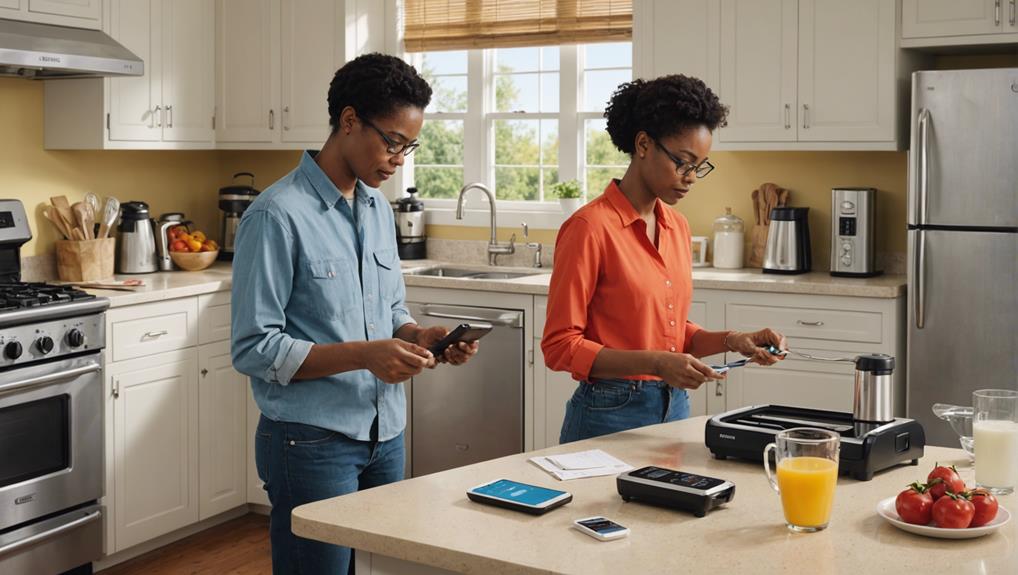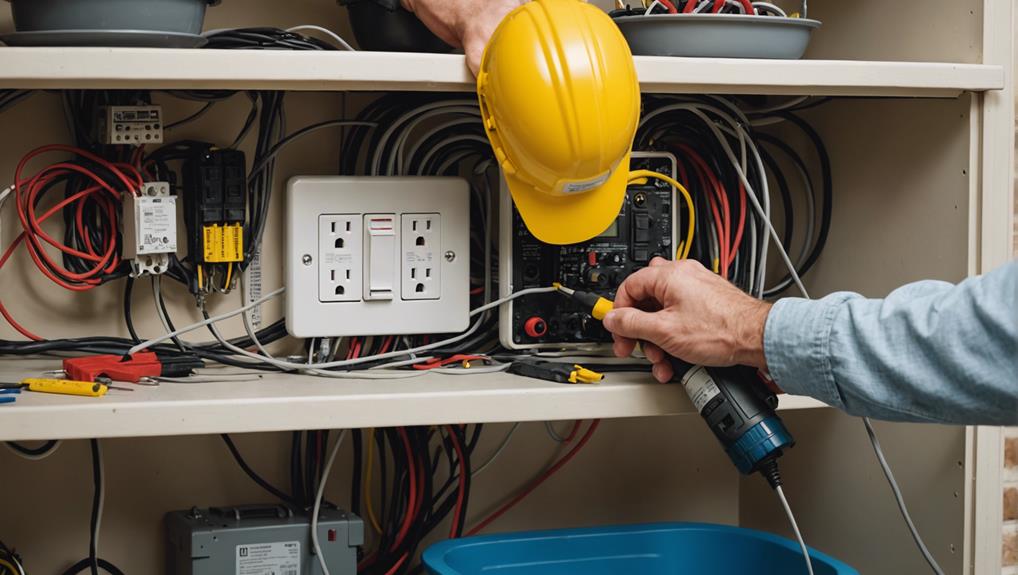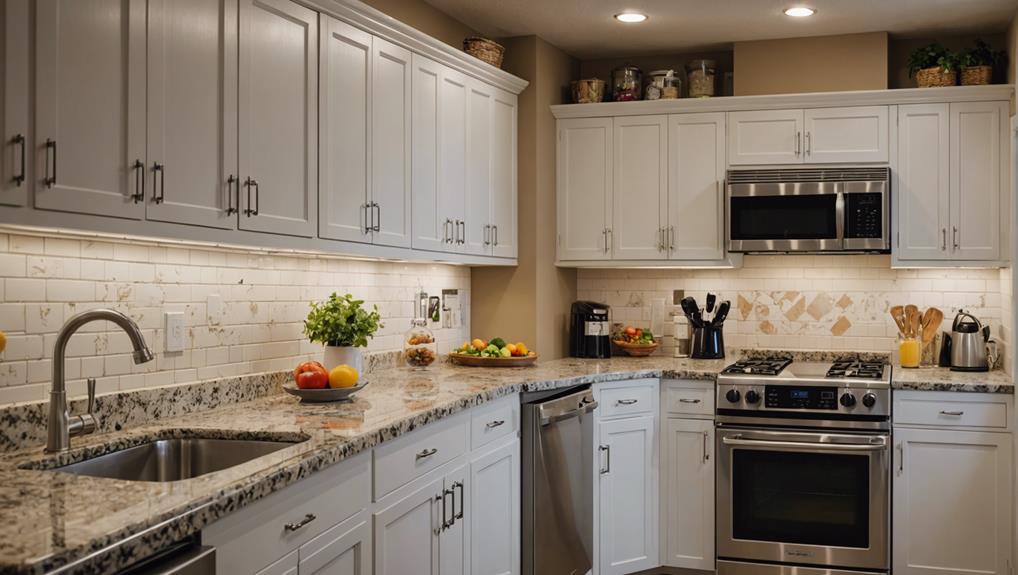
How to Comply With GFCI Code Requirements in Your Kitchen
To comply with GFCI code requirements in your kitchen, install GFCI protection for all outlets servicing countertops and areas within 6 feet of any sink, as mandated by the NEC 2020 standards. Use tamper-resistant GFCI outlets rated for the correct amperage. Make sure to turn off the power and use a voltage tester before installation. Regularly test outlets by pressing the 'Test' button and replace any faulty units immediately. Independent circuits for major appliances also aid in adherence to code. By following these steps, you'll guarantee your kitchen is up to code and enhance safety. Discover more advanced tips and best practices ahead.
Key Takeaways
- Install GFCI outlets for all kitchen countertop receptacles and outlets within 6 feet of a sink.
- Regularly test GFCI outlets monthly using the 'Test' and 'Reset' buttons to ensure functionality.
- Use tamper-resistant GFCI outlets for all 15-amp and 20-amp receptacles in the kitchen.
- Consult a qualified electrician to ensure compliance with NEC 2020 and local code requirements.
- Avoid overloading circuits by placing GFCI breakers in the electrical panel to protect multiple outlets.
Understanding GFCI Code
Understanding GFCI code is essential for ensuring your kitchen adheres to the latest safety standards and NEC 2020 requirements. GFCI installation in commercial kitchens isn't just a guideline; it's an important step towards enhancing electrical safety.
According to the NEC 2020 code, any kitchen appliance below 60 amperes, including dishwashers, must have GFCI protection. This is important because even small leakage currents can pose significant risks.
The GFCI works by employing a zero sequence current transformer to detect leakage currents. When it senses a discrepancy, it trips the circuit, cutting off power to prevent electrical shock and potential hazards. This immediate response is crucial in a kitchen environment, where water and electricity frequently intersect.
Moreover, advanced GFCI units like the Shock Block provide a continuous ground-check circuit. This feature ensures proper grounding verification in kitchen equipment, further enhancing electrical safety.
Compliance with GFCI code not only meets NEC standards but also greatly reduces electrical hazards, creating a safer work environment.
Proper GFCI installation and adherence to these codes are indispensable in maintaining a secure and compliant commercial kitchen. Ensuring electrical safety through these measures protects both personnel and equipment, making your kitchen a safer place to work.
Identifying Required Areas
To guarantee your kitchen complies with NEC 2020 standards, it's important to identify areas where GFCI protection is mandatory, such as countertop outlets and spaces near sinks. GFCI compliance isn't just a recommendation; it's a safety necessity to protect against electrical shocks in wet or damp environments like kitchens.
You need to focus on required locations, particularly where water and electricity are in close proximity. Any outlet within 6 feet of a sink must have GFCI protection. This includes countertop outlets where small appliances are often plugged in, increasing the risk of electrical hazards.
Additionally, check your local electrical codes for any specific requirements that might go beyond the NEC standards. Ensuring proper outlet placement near sinks and other water sources is important for safety.
Consulting with a qualified electrician can help you assess your kitchen for GFCI compliance. They can identify any overlooked areas and ensure all receptacles meet the required standards.
Prioritizing GFCI protection in required locations not only keeps you compliant with the code but enhances safety in your kitchen, preventing potential electrical shocks and hazards.
Installing GFCI Receptacles
To install GFCI receptacles in your kitchen, you'll need a few essential tools and materials, including a voltage tester and wire strippers.
Follow a step-by-step process to guarantee proper installation and compliance with code requirements.
Always consider safety and, when in doubt, consult a qualified electrician to verify the wiring and functionality.
Required Tools and Materials
You'll need a specific set of tools and materials, including GFCI receptacles, a voltage tester, wire strippers, a screwdriver, and wire connectors, to guarantee your kitchen complies with GFCI code requirements. Selecting the right GFCI receptacle is vital for providing ground fault protection in areas prone to moisture, like near sinks and countertops. Make sure the GFCI receptacle is rated for the correct amperage and voltage for your circuit.
Before you start any electrical work, use a voltage tester to verify that the power is off. Voltage tester safety is paramount to avoid electric shock. Follow proper outlet testing techniques by checking at multiple points within the receptacle to ensure it's de-energized.
When you're ready to wire the GFCI receptacle, wire strippers will help remove the insulation from the wires, allowing for proper wiring connections. Make sure to strip just enough insulation to fit securely into the receptacle terminals.
Wire connectors are essential for securely joining your circuit wires to the GFCI receptacle. They ensure a safe and reliable connection, preventing loose wires that could lead to electrical hazards. Using these tools and materials correctly will help you meet GFCI code requirements and maintain a safe kitchen environment.
Step-by-Step Installation
Having gathered your tools and materials, it's now time to turn off the power to the circuit you're working on to guarantee safety during the installation of your GFCI receptacle. Begin by removing the existing outlet and identifying the line and load wires. Properly distinguishing these wires is essential for a safe installation.
Follow the manufacturer's wiring instructions closely. Connect the line wires to the terminals labeled 'Line' and the load wires to the terminals labeled 'Load.' Secure each connection firmly to prevent any loose wiring, which is a common mistake that can lead to malfunction.
Once wired, secure the GFCI receptacle into the electrical box. Turn the power back on and press the 'Test' button on the GFCI. A successful trip indicates that the receptacle is functioning correctly. If it doesn't trip, double-check your wiring and refer to troubleshooting tips provided by the manufacturer.
Expert recommendations emphasize double-checking all connections and ensuring no wires are exposed. This not only complies with safety codes but also extends the lifespan of your installation.
Using GFCI Breakers
When using GFCI breakers in your kitchen, make sure they're installed correctly to meet code requirements and provide maximum safety.
Place them strategically to avoid overloading a single breaker with multiple circuits, which could cause nuisance trips.
Familiarize yourself with the diagnostic readouts on newer GFCI breakers to pinpoint and address specific fault codes efficiently.
Installation and Placement Tips
For thorough protection in your kitchen, install GFCI breakers in the electrical panel to safeguard multiple outlets on the same circuit. Proper GFCI breaker positioning is vital for thorough outlet protection. By placing the GFCI breaker at the beginning of the circuit, you guarantee that all downstream outlets receive protection from potential ground faults. This strategic placement enhances circuit coverage and strengthens overall safety.
When installing GFCI breakers, make sure the electrical panel is easily accessible. This enables quick identification and resetting in case the breaker trips. Label each breaker clearly to avoid confusion during maintenance or troubleshooting.
Remember, GFCI breakers offer improved safety by detecting even minor imbalances in current flow, which can prevent serious electrical hazards.
It's also essential to follow the manufacturer's instructions and local electrical codes when installing GFCI breakers. Proper installation ensures the breaker functions correctly, providing the necessary protection for your kitchen's electrical system. By adhering to these tips, you'll greatly enhance the safety of your kitchen, reducing the risk of electrical shock and ensuring a safer cooking environment.
Ensuring Code Compliance
To guarantee your kitchen complies with NEC standards, install GFCI breakers on circuits where ground faults are likely to occur. GFCI breakers protect entire circuits, shutting off power if a ground fault is detected, thereby enhancing safety.
Understanding the recent GFCI code updates is important. The NEC has tightened regulations, recommending GFCI breakers in more areas of the kitchen. This ensures thorough protection and adherence to safety protocols. Performing compliance verification through an inspection checklist is essential to confirm all required circuits are protected.
Properly testing GFCI breakers is another critical step. Regular tests ensure the breakers function correctly, maintaining safety standards. Familiarize yourself with GFCI breaker trip indicators; they help identify and diagnose electrical interruptions, making it easier to address issues.
Here's a quick checklist to help you:
| Task | Description |
|---|---|
| Install GFCI Breakers | For circuits in vulnerable kitchen areas |
| Understand Code Updates | Review recent NEC changes for kitchen GFCI use |
| Perform Compliance Verification | Use an inspection checklist to ensure adherence |
| Test GFCI Breakers | Regularly test to ensure functionality |
| Monitor Trip Indicators | Identify and resolve electrical interruptions |
Using GFCI breakers on multiple circuits prevents overloading, ensuring consistent protection throughout your kitchen. Always stay updated with GFCI code updates to maintain compliance and safety.
Testing GFCI Devices

Regularly testing GFCI outlets each month is a crucial step to guarantee the safety and functionality of your kitchen's electrical system. Begin by pressing the 'Test' button on the GFCI outlet; this should cut off power to the connected devices. If the power doesn't cut off, the GFCI outlet is faulty and needs replacement. Press the 'Reset' button to restore power.
Incorporate maintenance reminders into your schedule to make certain consistent safety checks. Some advanced GFCI devices feature error code indicators that assist in troubleshooting trips. These indicators can reveal whether the issue is a ground fault, overcurrent, or short circuit. Understanding these codes can help you pinpoint and resolve problems quickly.
For GFCI breakers, make sure they're listed for your specific panel to maintain compatibility and safety. Quality GFCI breakers will indicate the cause of a trip, enabling efficient troubleshooting. Regularly check these indicators to keep your kitchen's electrical system in top shape.
Placement Near Sinks
Placing GFCI outlets within 1.5 meters of sinks is a crucial requirement of the NEC code, aimed at preventing electric shocks in your kitchen. GFCI outlets are essential for sink safety, as they greatly reduce the risk of electrical hazards associated with water proximity. This critical positioning ensures that any electrical devices or appliances near the sink are protected, minimizing the risk of shock.
Proper outlet placement within 1.5 meters of the sink is not just a recommendation but a necessity for compliance with the NEC code. This guarantees that GFCI outlets can promptly trip in the event of a ground fault, providing an immediate response to potential hazards.
| NEC Requirement | Details |
|---|---|
| Distance | Within 1.5 meters of the sink |
| Purpose | Prevent electric shocks |
| Safety Focus | Sink safety, electrical hazards |
| Key Feature | Rapid trip response |
| Compliance | Mandatory for kitchen areas |
Coverage for Wet Areas

When addressing wet areas, make sure GFCI outlets are installed near sinks and any other potential water sources.
You should also place GFCI-protected outlets on countertops to cover appliances that might come into contact with water.
These practices not only meet code requirements but greatly enhance kitchen safety by preventing electrical hazards.
Sink Proximity Guidelines
In your kitchen, GFCI outlets must be installed within 1.5 meters of sinks to comply with NEC code requirements and enhance safety in wet areas. This proximity ensures that any outlet near a sink, where water is commonly present, is protected from causing electric shocks. The NEC mandates this to minimize the risk of water-related accidents and to guarantee the highest level of water safety.
Proper outlet proximity to sinks is vital in reducing electrical hazards in moist environments. By installing GFCI outlets within the specified range, you're actively preventing potential dangers that can arise from water exposure. This not only ensures compliance with safety standards but also provides peace of mind knowing that your kitchen is a safer place.
Here is a quick reference table to understand the key guidelines:
| Key Aspect | Requirement | Reason |
|---|---|---|
| Proximity to Sink | Within 1.5 meters | Ensures water safety |
| NEC Code Compliance | Mandatory for all kitchen installations | Prevents water-related accidents |
| Electrical Hazard | Reduced with proper GFCI placement | Minimizes risk in moist environments |
| Safety Standards | Enhanced by meeting GFCI requirements | Provides the best protection |
| Installation Check | Must be verified during kitchen inspections | Confirms adherence to code |
Countertop Outlet Placement
To guarantee your kitchen's electrical safety and compliance, place countertop outlets no more than 24 inches apart with GFCI protection in wet areas. This outlet spacing ensures you have convenient power accessibility while meeting electrical code requirements.
Proper placement minimizes electrical hazards, especially in areas prone to water contact, like near sinks and dishwashers.
Following these guidelines will help you achieve a safe and compliant kitchen:
- Outlet Spacing: Make sure outlets are no more than 24 inches apart along the countertop. This provides ample power accessibility without the need for extension cords.
- GFCI Protection: Install GFCI outlets within 6 feet of any water source. This is important for preventing electric shocks in wet areas.
- Coverage: Place GFCI outlets every 4 feet along the countertop to provide thorough coverage. This aligns with code requirements and enhances safety.
- Height: Position outlets above the countertop but below the upper cabinets, usually around 18 inches from the surface. This makes them easily accessible while keeping cords out of the way.
Ensuring Proper Functionality
Regularly testing your GFCI outlets and breakers guarantees they adhere to code requirements and maintain kitchen safety. Start by pressing the 'Test' button on each GFCI outlet to make sure it trips, then press 'Reset' to confirm it resumes functionality. Follow manufacturer guidelines for maintenance reminders and troubleshooting tips. Properly labeling your GFCI outlets and breakers helps you quickly identify them for routine safety checks and compliance with guidelines.
Understanding fault codes on GFCI breakers is important. When a breaker trips, check the code to pinpoint the issue, whether it's a ground fault, overload, or short circuit. This knowledge allows you to address problems promptly, maintaining a safe environment. If you encounter persistent trips, don't hesitate to seek professional help to make sure your kitchen remains compliant and hazard-free.
Regular safety checks are essential. Inspect the outlets for signs of wear, such as discoloration or a loose fit, which could indicate potential hazards. Adhering to compliance guidelines not only ensures safety but also prolongs the lifespan of your GFCI outlets and breakers. By staying proactive, you'll keep your kitchen both functional and secure.
Upgrading Existing Outlets

You'll need to assess your kitchen's current outlet configuration to determine how many GFCI outlets are required for compliance. Begin by mapping out the locations of all existing outlets, focusing on areas near sinks and countertops where GFCI protection is essential.
To upgrade your existing outlets, follow these steps:
- Outlet Positioning: Identify all necessary outlets for GFCI replacement, prioritizing those within six feet of water sources.
- Wiring Considerations: Turn off the power at the circuit breaker before removing the old outlets. Carefully follow the manufacturer's instructions for wiring the new GFCI outlets, ensuring that the line and load terminals are correctly connected.
- Aesthetic Integration: Choose GFCI outlets that match the style of your existing outlets. Consider outlet cover options that complement your kitchen's aesthetic, ensuring a seamless look.
- Functionality Check: Test each GFCI outlet after installation by pressing the 'Test' and 'Reset' buttons to ensure they trip correctly in case of a fault.
After upgrading, document the installation date for each GFCI outlet. This helps in future maintenance and guarantees ongoing compliance with safety codes.
If the process seems challenging, don't hesitate to hire a qualified electrician for professional assistance.
Safety Precautions
Ensuring the safety of your kitchen's electrical system begins with vigilant testing and maintenance of your GFCI outlets. Regularly test these outlets by pressing the 'Test' button and then the 'Reset' button to confirm they're functioning correctly. This important yet vital step helps in identifying potential electrical hazards before they become serious issues.
Implementing safety measures is essential. Make sure all kitchen outlets are tamper-resistant to prevent accidental shocks, especially in areas accessible to children. Childproofing these outlets can greatly reduce the risk of electrical hazards. Additionally, avoid overloading GFCI circuits with multiple appliances, as this can cause nuisance trips and compromise the efficiency of the system.
Here's a quick reference table for enhancing safety in your kitchen:
| Safety Measures | Description |
|---|---|
| Regular Testing | Test GFCI outlets monthly using the 'Test' and 'Reset' buttons. |
| Tamper-Resistant | Install tamper-resistant outlets to prevent shocks. |
| Avoid Overloading | Don't plug multiple high-power appliances into one GFCI outlet. |
| Childproofing | Use outlet covers and tamper-resistant designs to keep kids safe. |
Meeting Code Requirements

Consistently adhering to GFCI code requirements in your kitchen is essential for ensuring electrical safety and compliance. Understanding proper code interpretation and employing effective compliance strategies can prevent common mistakes and guarantee a smooth inspection process.
Here are four key points to keep in mind:
- Tamper-Resistant Outlets: Install tamper-resistant receptacles for all 15-amp and 20-amp outlets in kitchen-related areas to prevent accidental shocks.
- Countertop Receptacle Placement: Provide a receptacle for each countertop section that's 12 inches wide or more to accommodate appliances, and make sure that GFCI-protected receptacles are no more than 48 inches apart for accessibility.
- Separate Circuits for Fixed Appliances: Avoid sharing countertop receptacle circuits with fixed appliances like refrigerators to prevent overloading and maintain circuit stability.
- Dedicated Circuits: Follow NEC guidelines by having at least two 20-amp, 120-volt circuits for countertop and eating areas. This is essential for meeting GFCI code requirements and ensuring adequate power distribution.
Using an inspection checklist can help you avoid common mistakes and ensure your kitchen meets all necessary codes. Pay close attention to these guidelines to maintain both compliance and safety in your kitchen.
Frequently Asked Questions
What Are GFCI Requirements in a Kitchen?
You need GFCI installation for all 15-amp and 20-amp outlets in your kitchen to guarantee safety. This includes outlets near countertops and sinks, per NEC codes, to prevent electric shocks and enhance kitchen safety.
What Are the Code Requirements for GFCI Outlets?
You must have GFCI installation within 6 feet of sinks and for all countertop outlets in kitchens. Make sure you use the right GFCI types to meet NEC standards, enhancing safety and preventing electrical hazards effectively.
What Are Code Requirements for Kitchen Receptacles?
You're obligated to place kitchen receptacles no more than 4 feet apart on countertops. Make sure all 15-amp and 20-amp outlets are tamper-resistant. Monitor circuit load to avoid overloading and enhance electrical safety.
Where Do You Put a GFCI Outlet in the Kitchen?
You should place GFCI outlets near any countertop surfaces within 6 feet of a sink, focusing on appliance proximity. Make sure they're not obstructed by appliances or furniture, enhancing safety by quickly cutting power during electrical faults.
Conclusion
By following these steps, you'll guarantee your kitchen complies with GFCI code requirements.
Properly identify required areas, install GFCI receptacles and breakers, and regularly test the devices to ensure functionality.
Upgrading existing outlets enhances safety, while adhering to code ensures protection against electrical hazards.
Stay informed about the latest regulations and prioritize safety to maintain a code-compliant and secure kitchen environment.



Leave a Reply